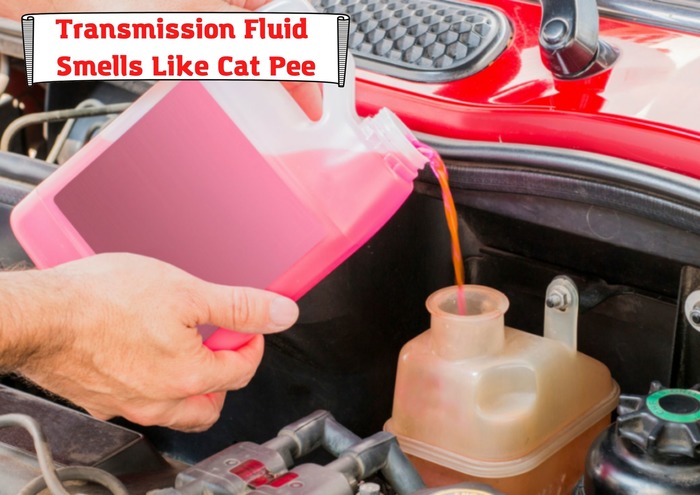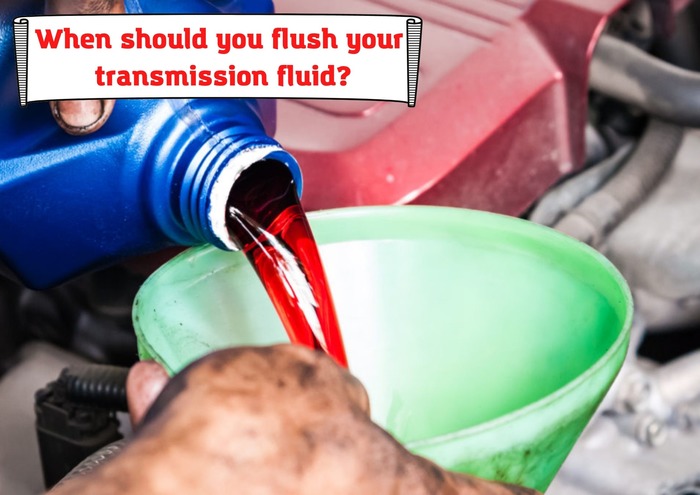
Transmission issues in cars are pretty inconveniencing and can vary in severity and repair costs. In some cases, a quick transmission fluid replacement is adequate, while some vehicles may need an expensive reconstruction. Luckily, by adhering to the early warning signs, such as smelly transmission fluid, you can address the issues early on to avoid breakdowns and costly repairs.
Bear in mind that sometimes smelly transmission fluid is just a normal thing because it contains Sulphur and can smell like rotten eggs or cat pee when it’s old enough and needs to be replaced. But please get acquainted with all possible reasons.
What is transmission fluid?
Transmission fluid is an essential part of the operation and performance of a car's transmission system. It is responsible for adequate lubrication of all the mechanical parts in the transmission to ensure optimal performance and reduce wear and tear. It also prevents rust and oxidation while maintaining cooler temperatures.
Besides lubrication, transmission fluid is also vital for providing the necessary hydraulic pressure inside the transmission. That means your car's gears require sufficient amounts of the appropriate transmission fluid to shift correctly. Overall, your vehicle will not work without a sound transmission unit and a suitable transmission fluid.
Why your transmission fluid smells like cat pee?
Over time, the transmission fluid will become contaminated and dirty because it also cleans metal parts in the transmission. Good transmission fluid is relatively pink or clear. However, if you see a dark brown color, there are more contaminants in the transmission fluid, which can cause several issues.
The smell of healthy transmission fluid is slightly sweet or relatively odorless. However, if it smells like burnt toast or cat pee, it is likely to require urgent service because the transmission unit is probably overheating. Besides the strange smells, there are several other symptoms of a bad or failing transmission fluid, as shown below.
How to know your transmission fluid is bad
It is vital to recognize and address transmission fluid issues as soon as possible to avoid damaging your transmission and engine. Here are a few signs that your car's transmission fluid is faulty:
Burnt or cat pee smell
The first sign you will instantly recognize regarding a failing transmission system is the foul smell originating from the transmission fluid. The grinding gears and increased friction in the transmission lead to overheating, which burns the fluid and causes that distinct burnt or cat pee smell.
Leaking transmission fluid
If there are leaks in your transmission unit, your car will lack sufficient transmission fluid to lubricate the numerous mechanical components effectively. It will cause the parts to overheat since they are not sufficiently cooled down.
Difficulty changing gears
If your transmission fluid is smelly or burnt, it will likely cause more issues with your gear changes. In addition, the gear changes can be abrupt and interfere with your overall driving and handling. Sometimes, it will even be impossible to shift gears.
Smoke
When your transmission fluid gets too hot, it can start producing smoke. Hence, if you see smoke and the foul transmission smell, it is a crucial warning sign that you should never ignore.
Overheated transmission
Most of the symptoms shown above relate to an overheated transmission. This issue can leave your car stranded until the transmission cools down. Ensure to get repairs done quickly to avoid destroying the complete transmission unit, which may cost lots of money in replacement or rebuilding.
How to get rid of foul-smelling transmission fluid
The best solution for fixing a bad-smelling transmission fluid is to do a replacement. The extent of the replacement will vary depending on the specific state of your transmission fluid. For instance, if you have driven your car for more than 100,000 miles while using the original transmission fluid, then you should consider draining and filling it with new transmission fluid.
What causes smelly transmission fluid?
As mentioned above, the primary cause of a burnt or cat pee smell from a car's transmission fluid is overheating. A transmission system can overheat due to various reasons, including:
- Sustained duration on high loads
A common reason for overheated transmission is running it too hard for a long time. For instance, if you often have two weighty loads, drive on steep hills, or participate in track days, your transmission is much more likely to overheat. You can mitigate these issues by installing external transmission system coolers or ensuring you use the appropriate vehicles for your specific driving conditions.
- Insufficient transmission fluid
The other reason why your transmission is overheating is inadequate transmission fluid. Besides ensuring optimal hydraulic pressure for gear changes, the transmission fluid also plays an essential job in lubricating the internal components. Hence, running your car with chronically insufficient transmission fluid enhances your likelihood of an overheated transmission.
- Solenoid problems
Solenoids are an essential component within the transmission that controls downshifting and upshifting. Bad solenoids can lead to overheated transmission, pressure issues, shifting difficulties, and error codes on your dashboard.
What to do when you notice your transmission fluid smells like cat pee
You should never ignore transmission issues as it endangers the transmission's internal components and your entire vehicle. You should seek professional help from a local repair shop where you can get your transmission fluid flushed.
The process of flushing a transmission fluid involves draining the old and worn-out fluid. Afterward, your mechanic adds a fresh, high-quality transmission fluid into the car to keep it healthy. While doing this job, they will also inspect your transmission system to check for any signs of trouble, including potential fluid leakage and other transmission problems.
When should you flush your transmission fluid?

Ensure to read your owner's car manual to get more insight on the optimal frequency of transmission fluid flushing. Generally, you will need to get this service every couple of years. It is best to consult an experienced mechanic for more insight into this matter to guarantee you have the most relevant information to make your decision.
Can you fix smelly transmission fluid as a DIY project?
You can do certain vehicle repair tasks at home if you've got all the necessary tools and appropriate know-how. However, unlike basic repair jobs like changing the bulb or tire maintenance, flushing a transmission requires more knowledge than most average car owners have. Thus, while you can quickly detect transmission fluid issues at home, visiting a mechanic for the actual flushing and repair job is recommended.
While it may seem tempting to forego transmission maintenance due to its high serving costs, fixing this crucial part of the car guarantees a safer and better driving experience. Therefore, you should not skimp on spending money and time fixing your transmission fluid. Let experts diagnose the issue and resolve it as soon as possible to maintain a reliable, well-functioning car.
How to avoid smelly transmission fluid?
Here are a few practical and straightforward steps to prevent transmission fluid issues:
- Maintain the cooling unit
The radiator in the gearbox of your car helps to reduce the transmission fluid's temperature by running coolant through several metal fins. It allows the transmission to maintain a well-balanced working temperature, thus preventing overheating. Besides inspecting that your radiator is working correctly. Though, not all cars have such radiators.
- Check transmission fluid levels regularly
Inspect your transmission fluid regularly with a dipstick (if your car has one) to guarantee you have sufficient fluid in your system to lubricate all the various parts effectively. If you notice that the fluid level is lower than expected, then it could mean your transmission could start having problems soon. Follow your car manufacturer's recommendations on refilling the transmission fluid.
- Change your transmission fluid
In most cars, you can replace the transmission fluid after every 50,000 miles or more often for those that haul heavy loads or drive long trips in hot regions. Replacing the fluid maintains transmission efficiency and reduces wear, thus reducing the potential of overheating.
- Be alert for the symptoms of a bad transmission
The other way to prevent a smelly transmission is to stay alert and watch out for the symptoms of a failing transmission. If you notice any leaks or if you experience jerky gear shifts, then your transmission unit might have potential issues. Consider getting prompt repairs before the problem becomes more severe.
Conclusion
If your transmission fluid smells like cat pee, it is among the top signs that your car has issues with its manual or automatic transmission system. The reason for that foul smell is an overheated transmission, and you should contact a mechanic to prevent a complete mechanical breakdown. You should never drive your car without sufficient transmission fluid as it is vital for lubrication, cooling, and other crucial tasks like shifting gears.
The good thing is that as soon as a mechanic cleans and refills your transmission fluid, you should not have any other issues with the overheated transmission or smelly transmission fluid. In addition, ensure to regularly inspect the transmission fluid as part of your vehicle maintenance tasks. Always confirm that you have sufficient transmission fluid and that it isn't discolored or smelly, and also that it's maintaining the recommended temperature.
About the authors
The CarAraC research team is composed of seasoned auto mechanics and automotive industry professionals, including individuals with advanced degrees and certifications in their field. Our team members boast prestigious credentials, reflecting their extensive knowledge and skills. These qualifications include: IMI: Institute of the Motor Industry, ASE-Certified Master Automobile Technicians; Coventry University, Graduate of MA in Automotive Journalism; Politecnico di Torino, Italy, MS Automotive Engineering; Ss. Cyril and Methodius University in Skopje, Mechanical University in Skopje; TOC Automotive College; DHA Suffa University, Department of Mechanical Engineering






Add comment